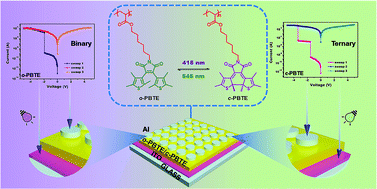Construction of polymer materials with specific responses to violet and green lights and their potential applications in an artificial visual memory system†
Abstract
Artificial retinal materials play an important role in vision repair and robotics. However, the inability to convert characteristic visible light signals into electrical signals has seriously hindered the development and application of artificial retinal materials. Herein, photoresponsive polymers containing dithienylmaleimide groups in the side chains are designed and synthesized; the dithienylmaleimide groups react cyclically under the irradiation of green light and violet light, forming two isomers called o-PBTE and c-PBTE, respectively. These two isomers exhibit binary and ternary electrical signals and can be converted to each other under the control of violet light and green light. UV-vis and XRD measurements show that the binary response behavior in o-PBTE is the result of only charge transfer (CT), while the ternary response behavior in c-PBTE is realized by both the conformational change and CT mechanism under the action of an electric field. This material with accurate response and memory to specific wavelengths of visible light, excellent anti-fatigue performance and high stability provides a promising strategy for realizing the synergy of light and electricity to achieve multi-level data storage, and it may be applied to the optical identification technology of artificial retinal materials.



 Please wait while we load your content...
Please wait while we load your content...